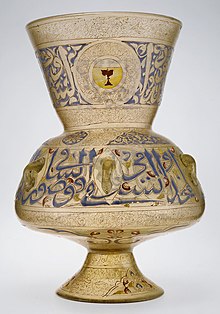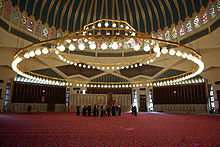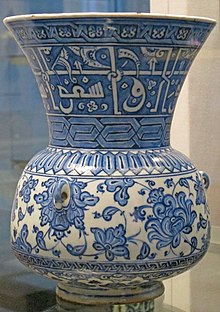
The arabesque is a form of artistic decoration consisting of "surface decorations based on rhythmic linear patterns of scrolling and interlacing foliage, tendrils" or plain lines, often combined with other elements. Another definition is "Foliate ornament, used in the Islamic world, typically using leaves, derived from stylised half-palmettes, which were combined with spiralling stems". It usually consists of a single design which can be 'tiled' or seamlessly repeated as many times as desired. Within the very wide range of Eurasian decorative art that includes motifs matching this basic definition, the term "arabesque" is used consistently as a technical term by art historians to describe only elements of the decoration found in two phases: Islamic art from about the 9th century onwards, and European decorative art from the Renaissance onwards. Interlace and scroll decoration are terms used for most other types of similar patterns.

Islamic art is a part of Islamic culture and encompasses the visual arts produced since the 7th century CE by people who lived within territories inhabited or ruled by Muslim populations. Referring to characteristic traditions across a wide range of lands, periods, and genres, Islamic art is a concept used first by Western art historians in the late 19th century. Public Islamic art is traditionally non-representational, except for the widespread use of plant forms, usually in varieties of the spiralling arabesque. These are often combined with Islamic calligraphy, geometric patterns in styles that are typically found in a wide variety of media, from small objects in ceramic or metalwork to large decorative schemes in tiling on the outside and inside of large buildings, including mosques. Other forms of Islamic art include Islamic miniature painting, artefacts like Islamic glass or pottery, and textile arts, such as carpets and embroidery.
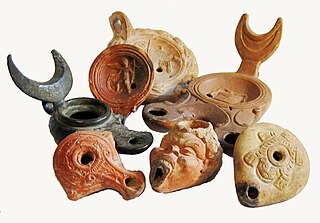
An oil lamp is a lamp used to produce light continuously for a period of time using an oil-based fuel source. The use of oil lamps began thousands of years ago and continues to this day, although their use is less common in modern times. They work in the same way as a candle but with fuel that is liquid at room temperature, so that a container for the oil is required. A textile wick drops down into the oil, and is lit at the end, burning the oil as it is drawn up the wick.

The Blue Mosque in Istanbul, also known by its official name, the Sultan Ahmed Mosque, is an Ottoman-era historical imperial mosque located in Istanbul, Turkey. It was constructed between 1609 and 1617 during the rule of Ahmed I and remains a functioning mosque today. It also attracts a large number of tourists and is one of the most iconic and popular monuments of Ottoman architecture.

A chandelier is an ornamental lighting device, typically with spreading branched supports for multiple lights, designed to be hung from the ceiling. Chandeliers are often ornate, and they were originally designed to hold candles, but now incandescent light bulbs are commonly used, as well as fluorescent lamps and LEDs.

A prayer rug or prayer mat is a piece of fabric, sometimes a pile carpet, used by Muslims, some Christians, especially in Orthodox Christianity and some Baha'i during prayer.

The Nasir al-Mulk Mosque, also known as the Pink Mosque, is a traditional mosque in Shiraz, Iran. It is located near Shāh Chérāgh Mosque. It was built during Qajar dynasty rule of Iran.
The Verse of Light is the 35th verse of the 24th surah of the Quran (Q24:35).

Turkish art refers to all works of visual art originating from the geographical area of what is present day Turkey since the arrival of the Turks in the Middle Ages. Turkey also was the home of much significant art produced by earlier cultures, including the Hittites, Ancient Greeks, and Byzantines. Ottoman art is therefore the dominant element of Turkish art before the 20th century, although the Seljuks and other earlier Turks also contributed. The 16th and 17th centuries are generally recognized as the finest period for art in the Ottoman Empire, much of it associated with the huge Imperial court. In particular the long reign of Suleiman the Magnificent from 1520 to 1566 brought a combination, rare in any ruling dynasty, of political and military success with strong encouragement of the arts.
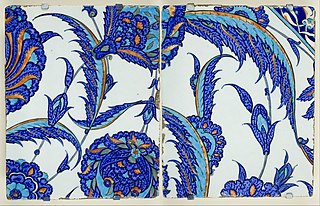
Iznik pottery, or Iznik ware, named after the town of İznik in Anatolia where it was made, is a decorated ceramic that was produced from the last quarter of the 15th century until the end of the 17th century. Turkish stylization is a reflection of Chinese Porcelain.

Turkish or Ottoman illumination refers to non-figurative painted or drawn decorative art found in manuscripts or on sheets in muraqqa. In Turkish it is called “tezhip”, meaning “ornamenting with gold”. The Classical Islamic style of manuscript illumination combines techniques from Turkish, Persian, and Arabic traditions. Illumination was central to the traditional arts of the Ottoman Turks, who developed a style of illumination distinct from earlier traditions.

The Qalawun complex is a massive pious complex in Cairo, Egypt, built by Sultan al-Mansur Qalawun from 1284 to 1285. It is located at Bayn al-Qasrayn on al-Mu'izz street and like many other pious complexes includes a hospital (bimaristan), a madrasa and mausoleum. Despite controversy surrounding its construction, this building is widely regarded as one of the major monuments of Islamic Cairo and of Mamluk architecture, notable for the size and scope of its contributions to legal scholarship and charitable operations as well as for the richness of its architecture.
Misbah is a Muslim Arabic name meaning "lamp" or "light". This name has originated from The Qur'an from Ayatu-n-Nur, also known as the Ayat of light, from the following verse:
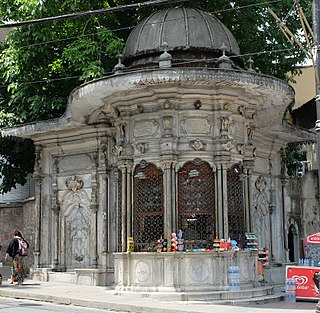
A sabil or sebil is a small kiosk in the Islamic architectural tradition where water is freely dispensed to members of the public by an attendant behind a grilled window. The term is sometimes also used to refer to simple unmanned fountains with a tap for drinking water, though other names often exist for such fountains.

Sulayman Pasha al-Khadem Mosque, also known as Sariat al-Jabal Mosque, is a historical mosque established in 1528 by Suleiman Pasha Al-Khadem, one of the Ottoman rulers of Egypt. It is located inside the Cairo Citadel at the top of Mount Mokattam, and originally erected for the use of the janissaries stationed in the northern enclosure. It is the first mosque established in Egypt in Ottoman architectural style.

Enamelled glass or painted glass is glass which has been decorated with vitreous enamel and then fired to fuse the glasses. It can produce brilliant and long-lasting colours, and be translucent or opaque. Unlike most methods of decorating glass, it allows painting using several colours, and along with glass engraving, has historically been the main technique used to create the full range of image types on glass.

Arabic miniatures are small paintings on paper, usually book or manuscript illustrations but also sometimes separate artworks that occupy entire pages. The earliest example dates from around 690 AD, with a flourishing of the art from between 1000 and 1200 AD in the Abbasid caliphate. The art form went through several stages of evolution while witnessing the fall and rise of several Islamic caliphates. Arab miniaturists absorbed Chinese and Persian influences brought by the Mongol destructions, and at last, got totally assimilated and subsequently disappeared due to the Ottoman occupation of the Arab world. Nearly all forms of Islamic miniatures owe their existences to Arabic miniatures, as Arab patrons were the first to demand the production of illuminated manuscripts in the Caliphate, it wasn't until the 14th century that the artistic skill reached the non-Arab regions of the Caliphate.
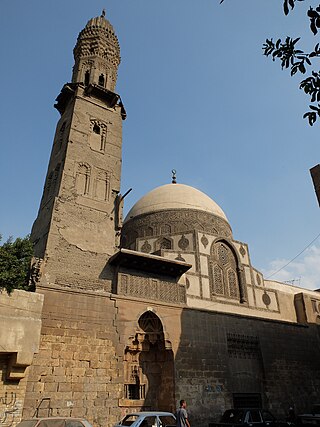
The Madrasa of Amir Sunqur Sa'di, also commonly known as the Mausoleum of (Sheikh) Hasan Sadaqa, is a medieval Mamluk-era madrasa structure and mausoleum in Cairo, Egypt. It was originally built between 1315 and 1321 CE by amir Sunqur Sa'di. Sunqur was forced to leave Egypt in his lifetime and was never buried there, but a sheikh known as Hasan Sadaqa was later buried in it and therefore the building is often known by his name. From the 17th century onward the complex was converted into Mevlevi Sufi lodge and is open today as the Mawlawiyya Museum or Museo Mevlevi.

The Mosque of Qaytbay, also known as the Madrasa of Qaytbay, is a historic religious structure in the Qal'at al-Kabsh neighbourhood of Cairo, Egypt. Completed in 1475, it is one of multiple monuments sponsored by the Mamluk sultan al-Ashraf Qaytbay. It is not to be confused with the more famous Funerary complex of Qaytbay in the Northern Cemetery. It is described as both a madrasa and a mosque by scholars, but functions as a mosque today.

Mahya lights are decorative lights which are strung up between the minarets of Turkish mosques to form illuminated words or pictures on festive occasions such as Eid al-Fitr, Eid al-Adha, on Kandil nights, and throughout the holy month of Ramadan.
